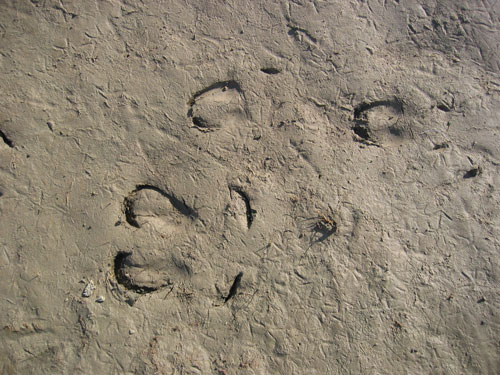( Log In ) Log In is for TREC Teachers & Researchers only
  |
| Leslie_Pierce |
 Jul 17 2005, 07:35 AM Jul 17 2005, 07:35 AM
Post
#1
|
 TREC Teacher    Group: TREC Team Posts: 172 Joined: 27-April 05 Member No.: 7 |
July 14, 2005
Today was a long day of walking and sampling. We finished the other four transects on this island in about eight hours, averaging about two hours per transect or about 12 minutes per sample. Whew, no wonder I’m tired! The first half of the sampling day the weather was really nice. Not too cold, not too windy but enough to keep the bugs away. We were walking a transect just south of our camp when we came upon a Pacific Loon on her nest. She flushed off so we went to get a look. There were two nice greenish-brown eggs sitting on the mud. Not a very warm nest. Brian floated the eggs and estimated that they should hatch in a few days, so we’ll have to go back and try to get a look at the chicks. Loon nest just south of camp  The area just south and west of our camp is pretty bleak looking. It’s highly devegetated in many spots, looking more like a moonscape than tundra. There has obviously been a lot of use by snow geese and we saw many nests to indicate that nesting pairs were here to forage. The snow geese are not in the immediate area anymore but are off a bit farther in the distance with their young. The young walk the tundra with their parents foraging on the vegetation that is now green. When the snow geese first arrive here in May they grub for the only available food, underground roots. Now their feeding options include the above ground shoots of grasses and sedges. During the second half of our sampling day, which started at about 5:30 pm, it started to rain. Just a few sprinkles here and there until we got back to camp when it continued to drizzle throughout the night. We had a few bugs today, mostly midges buzzing around our heads with a few mosquitoes here and there, but it wasn’t too bad at all. Near the south end of our island we’ve been watching caribou cross the river channel since we arrived. Today, we could hear them crashing as they ran and jumped into the water to cross and then ran off northeastward towards the coast. They had been leisurely crossing before so we suspect that the buzzing midges may have them moving a little faster. The mosquitoes are not bad for us yet, but maybe there are more following the caribou. There are other insects that the caribou try to run away from. Nose Bot flies lay their eggs in the nose of the caribou. Warble flies lay their eggs on the rear legs of caribou. The hatched warble fly larvae burrow under the skin and migrate to the back of the caribou to spend the winter there until they emerge as adults the following summer. Caribou use the coastal areas of the North Slope as insect relief areas. The consistent breeze coming off of the Arctic Ocean keeps the bugs away!  Cow and calf tracks seen in mudflat where caribou where crossing the channel. Back at camp just before 10 pm, we weighed the soil samples for wet weight. They will be taken back to the lab for dry weight measurements and soil salinity. Brian is using a battery-powered electronic balance in his makeshift tent lab. Brian weighing soil core samples in his tent!  Tomorrow we will try to kayak over to ABR Island, given that name because of the biologists from ABR that are camping there! |
  |
1 User(s) are reading this topic (1 Guests and 0 Anonymous Users)
0 Members:

|
NSF Acknowledgment & Disclaimer | Time is now: 2nd November 2024 - 02:42 PM |
Invision Power Board
v2.1.7 © 2024 IPS, Inc.








